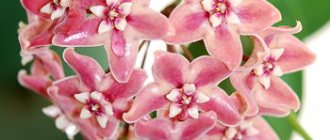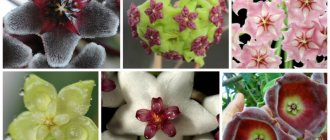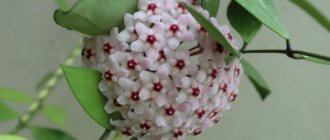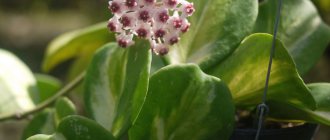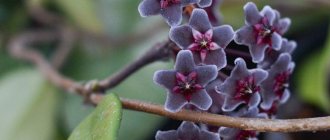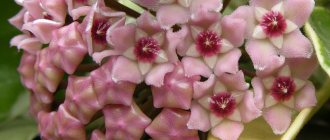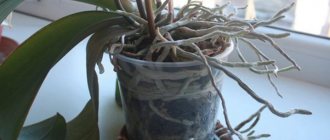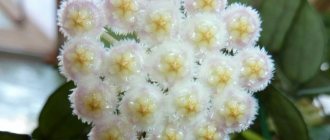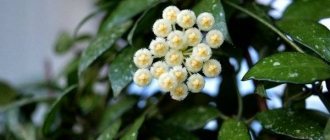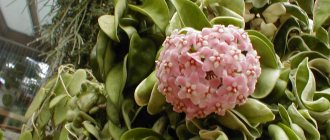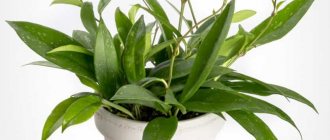- Cuttings.
- For this you need a part of the trunk with 2-3 leaves.
The roots are sprouted in a container with water, and Kornevin and activated carbon are added there.
- If the room is warm, you don’t have to cover anything on top.
- In a month the roots will emerge, it’s time to plant them in a pot.
- Stem layering .
This option is the simplest, although it is used much less often. Aerial roots should be placed in moist soil or moss, and this way they will take root easily. The process will not take much time, and after a year the plant will bloom. - Seed method .
The method is not used at home. Thus, hoya reproduces only in its natural habitat. Only specialists can raise a plant from seeds.
This method is the most common and reliable. The cutting method is simple to perform and even novice gardeners can do it. It is possible to get a new copy similar to the mother one.
We talked about how to properly propagate and care for various types of Hoya in other articles on our website. Read about varieties such as Curtisi, Cumingiana, Obovata, Vaieti, Multiflora, Macrophylla, Gracilis, Compacta, Matilda and Lacunosa.
Features of care and reproduction
Lighting
The plant prefers diffused sunlight, so you should not expose Hoya to the sunny side of the window. But if the windows in your house do not face the south-east and/or south-west, then you need to protect the flower as much as possible from sunburn on the south window.
Room temperature
The optimal temperature for good plant growth is from plus eighteen to twenty-five degrees in the summer and from plus fifteen to seventeen degrees in the winter.
Read also Harvesting beans for the winter at home
Rest period
The vine does not have a main, pronounced period of rest, but if you consider that in winter the air temperature is slightly lower than in summer, you might think that at this time the plant will have time to rest in order to gain more strength before rapid growth and flowering in the summer. .
Humidity
Fortunately, for many gardeners, the vine does not need high humidity. But this does not mean that it will not respond with lush flowering to a warm shower. If we are talking about spraying from a spray bottle, then this should be done only if the air temperature heats up above twenty-five degrees or during abnormal heat or drought that lasts for a long time. This will help prevent a decline in leaf turgor and keep the plant in good shape.
Watering
Watering should be such that the roots have time to absorb water from the previous watering, but do not dry out. If there is water left in the tray when watering, then you should wait about half an hour until the plant absorbs additional water, and everything that remains needs to be poured out to prevent rotting of the root system. Hoya, like many other plants, needs to be watered with settled water, which is heated to room temperature. Under no circumstances should you water your hoya with cold water during the daytime in summer. Cold water will have a bad effect on soil steamed from sunlight!
Transfer
The plant should be replanted when the roots of the flower are visible or come out through holes to drain excess water. Replanting can be done either by transferring from one pot to another, or by washing the roots from the old soil and replanting them into a new substrate.
Reproduction
Reproduction can occur either by layering from an adult plant or by cuttings.
- In the first case, one of the branches of the vine is planted in another pot or placed on the surface of the ground with moss to provide more moisture. You can also install a small greenhouse.
And then they wait for the vine to give new roots and shoots. The mother branch can then be cut off. In the second case, the vine is cut into small cuttings and planted in pots.
It is also recommended to install a greenhouse here. It must be remembered that the greenhouse must be ventilated from time to time to prevent plant rotting.
Under no circumstances should you over-wet the soil. For better results, before planting the cutting, you can dip it in Kornevin.
The cuttings can be planted directly into the ground, or you can put them in water and wait until good roots appear and only then plant them in the ground. Both methods will be correct if all conditions are met.
Caring for Hoya at home
For home cultivation, Hoya is usually purchased in two types: Beautiful or Fleshy. In order for Hoya to grow well in your apartment, you need to create conditions for it that are close to its usual tropical conditions. Here are the basic rules for caring for a flower.
Flower content temperature
Hoya feels great at a normal room temperature of 20 - 30 °C. Loves fresh air - ventilate the room. But it is not at all necessary to take it outside. Moreover, you should not expose her to cold drafts. Wipe off dust from the leaves and spray them regularly. In winter, the flower will withstand temperatures dropping to 15 °C. But the temperature is below 10 °C. The Hoyas may not survive. Winter flower maintenance at 16 – 18 °C. necessary for regular annual summer flowering of Hoya. This period of Hoya’s life is considered conditionally a period of rest.
Yellowing and falling leaves are often a sign of flower hypothermia!
Location and lighting
If the plant does not like its location, it may not bloom. Let's consider all the options in order.
Hoya is not afraid of a little shade. If you place it near eastern or western windows, it will not only grow well, but also bloom profusely all summer and until mid-autumn. It must be protected from direct sun. As one option, you can place the vine against the wall in the southern room. Like an hanging plant, it will cover the entire wall and become the highlight of your home.
But, one should take into account the fact that Hoya does not like to be moved from place to place. If you move it from place to place or hang it on other walls, then it will simply lose all the buds and even shed all the leaves. This plant is completely unsuitable for summer landscaping on balconies, loggias or verandas.
You should not place the pot on the windowsill - it will not tolerate direct sunlight, and it will not like the proximity of heating devices in the autumn-winter time - Hoya may get sick and die.
The daylight hours should be long enough. If cloudy days occur during flowering, it is advisable to improve its lighting using a fluorescent lamp or phyto lamp so that daylight lasts at least 12 - 14 hours a day. The same applies to the winter period of her life, only 10 hours of lighting per day will be enough.
When choosing a place for a flower, you must remember that during flowering Hoya emits such a strong aroma, especially at night, that you will definitely want to take it out, for example, from the bedroom (which can lead to the shedding of not only flowers, but also leaves), or you will have to constantly ventilate the room.
And one more important condition. For trouble-free growth and development of the plant, different types of support are needed: posts, trellises, trellises, all kinds of arcs in the shape of a heart, ring or arch. They are simply necessary in order to tie to them numerous flexible and rather long shoots of the plant - vines. Although, it is possible to grow Hoya as a shrub. Then you will have to frequently pinch out the growing shoots.
Features of Hoya flowering
Tropical liana loves bright but diffused sunlight. Receiving it in abundance, Hoya will bloom profusely and for a long time with beautiful fragrant inflorescences. Choose the location of the flower so as not to move the pot from place to place during the period of bud formation and flowering, since the plant can partially shed both buds and flowers. Stems with clusters of flowers should be securely supported so that they are always in an upright position. After flowering, long shoots should be cut off, but short and flowering shoots should be left.
Do not touch the flower stalks either - after a while buds will appear on them again.
Watering
From March to October, Hoya should be watered regularly and moderately. About once a week. The water should be soft. If you use chlorinated tap water, it should sit for 24 hours so that all impurities precipitate and the chlorine evaporates. Be sure to remove excess water that has accumulated in the pan so as not to provoke rotting of the root system of the flower. In summer, it is necessary to water the plant after the soil has dried out from the previous watering to about one to two cm from the surface. From November, watering is reduced. The plant is watered a couple or three days after it is noticed that the top layer of soil has become dry. About twice a month. You shouldn’t water Hoya at all in the autumn-winter period - its roots will begin to die, and by spring the plant will become weakened and may die.
Bathing
Twice a year, in the spring before flowering and in the fall after flowering, Hoya is bathed. A pot with a flower is lowered into a large basin with hot water heated to 30 - 40⁰C. After 7 - 10 minutes, the stems of the plant are pulled out of the water, and the earthen lump remains in the hot water for another half an hour.
This may be interesting: Sansevieria (Sansevieria) - unpretentious perfection
Spring bathing will significantly speed up the approach of flowering and promote rapid growth of ivy. Autumn bathing will harden the flower and give it strength to survive the difficult winter time.
Ambient humidity
For Hoya, air humidity is not a determining factor. It will grow at normal room humidity. If the air in the room is too dry, it is enough to place the flower pot in a tray with wet expanded clay and regularly spray the surrounding air.
Transplant and pot
The liana grows quite quickly. Within a year, its length will reach 30 cm. Its roots also grow. Therefore, we recommend replanting young plants every spring into new pots, 2 - 3 cm larger than the old ones. Keep in mind that in a more spacious pot, Hoya will feel more comfortable, its shoots will grow faster, adding 30 - 50 cm per year. But in a slightly cramped pot it will bloom more profusely. Therefore, you choose what is more important to you in the coming year - either to grow more young shoots, or to make Hoya bloom profusely. Hence the size of the new pot.
An adult plant needs to be replanted less often - once every 3 - 4 years. The optimal pot size for an adult plant is 18 – 20 cm.
Replant by transferring the plant along with the earthen ball into a new pot. Do not forget about drainage - expanded clay or broken shards, laid at the bottom of the flowerpot at a third of its height. If there is a need to completely replace the old soil with a new one, carefully free the Hoya root system from the old soil, remove dried or rotten roots, and powder the cut areas with crushed coal. And only then plant the plant in a new pot and cover it with new nutrient soil.
It is better to choose a ceramic pot for Hoya, since its walls allow air to pass better to the roots. We recommend disinfecting any pot before use.
If you purchased a plant specimen in a store in bloom, you should not immediately replant it in your pot. Wait until the last inflorescences wither, and only then begin transplanting the plant from the store container into your own container. If possible, it is better to postpone this event until next spring.
Soil and fertilizing
Hoya prefers loose, breathable soil, neutral or slightly acidic, where the pH does not exceed 6.5. Usually the vine is not whimsical. Suitable soil consists of leafy soil, turf soil, peat, and sand. Add a little charcoal and pieces of sphagnum moss.
Of the ready-made mixtures for Hoya, soil for orchids is suitable.
Wax Ivy responds well to fertilizing with mineral fertilizers during the growing season. For Hoya, liquid complex fertilizers for orchids and other flowering succulents are suitable. One feeding every two weeks is enough. Do not violate the instructions; it is better to take fertilizers a little less than the norm - excess microelements will negatively affect the appearance of the flower.
Immediately after planting or replanting a plant, do not feed it for two to three months, provided you use nutritious soil. In winter, you should not feed the plant either.
Trimming
Frequent trimming and pinching is not really necessary for Hoya. In young plants, after the fourth leaf appears, the branch is pinched to form new shoots. Sometimes, in order to beautifully form a bush, Hoya shoots that are too elongated are pruned. Pruning is done with pruning shears. The stem is cut in the interval between the nodes. This pruning encourages the plant to produce new side shoots and encourages the plant to bloom profusely.
But you shouldn’t cut off the flower stalks after the inflorescences dry out - new flowers will appear on them in the future.
Diseases and pests
| Problem | Symptoms | Prevention | Treatment |
| Mealybug | Cotton-like coating, slowdown in growth and development. | Spraying, showering, airing, quarantine for new flowers. | Clean off plaque and insects with a brush in a soapy solution, wash with water, and spray with infusion of tobacco or calendula. In case of severe damage, use Aktara, Fitoverm or Tanrek. |
| Aphid | Small light green bugs. Curling and drying of leaves. | Cut off the wilted, affected leaves and wash the plant with tar soap. In serious cases, use insecticides (Intavir, Fas, Karate). | |
| Whitefly | Larvae and flying insects. Honeydew in the form of plaque and black sooty fungus. | Wash the Hoya with an alcohol-soap solution. Hang sticky traps for winged pests and collect caterpillars by hand. Change the top layer of substrate in the flowerpot. In case of serious damage, use Actellik or Confidor. | |
| Rotten | Stunting, wilting, falling leaves. Thinning, darkening and softening of stems. | Avoid overwatering. Disinfect the soil, pot, drainage, tools. | Remove damaged parts of the hoyka and treat with an antiseptic. Apply fungicides (Trichodermin, Mikosan, Topaz). Transplant the flower into a new substrate. |
Flower design
Hoya Compacta is beautiful in its own right. But from a design point of view, it can be combined with other varieties of hoya, such as Hoya Kerry. Use the Hoya obovata variety with its snow-white inflorescences with other varieties. Combine different inflorescences, as the neutral white color that Hoya obovata has will dilute the variegated colors of other varieties. Also plant at the foot of other plants so that as they grow, they wrap around the trunk and cover the foot of the plant. If all conditions for caring for this beautiful plant are met, you can achieve abundant flowering and lush, dense foliage. This indoor plant will fit perfectly into the interior of your home. Your Hoya, which is not too labor-intensive to care for, will delight you with its beauty. Good luck to you.
Description of the plant
In fact, this species grows on the islands of Fiji, Australia, Asia, Samoa, on the coast of South Wales, Vanuatu. It grows especially abundantly in coastal areas, and is also often found on the edges of tropical forests or rocky areas.
Hoya australis is grown to decorate residential and public spaces. Attracts flower lovers to its glossy green leaves and creamy blossoms with a cherry center.
The arrangement of foliage is opposite, the structure is dense, leathery, oval or round in shape. The size of the leaf plate is 2-12cm wide and 3-15cm long. The ends of the leaves are pointed, rounded, the edges are curved. The base of the leaf is smooth or with fine fine hair. The color of the foliage depends on the lighting; in the sun it is light green, and in the shade it is dark green.
Hoya peduncle grows in height, reaching 8-30mm. At the tops of these processes there are umbrella-shaped inflorescences. The number of flowers in such an inflorescence is 10-15 pieces.
The corolla of the flower is cup-shaped, diameter 1-2.5 cm. The shape is a five-pointed star, the color of the petals is creamy-white, with a scarlet center inside. The shape of the petals is oval with wavy, slightly curved edges. These flowers emit an unusual, intoxicating aroma and also secrete sugar nectar. The fruits of Hoya australis are long and narrow capsules up to 13 mm in size and about 1 cm in diameter. The seeds themselves are cinnamon in color.
The most popular subspecies of southern Hoya is Hoya Australis Lisa.
Hoya southern
Growth:
Indonesia, Australia (Eastern and Northern Australia from the Northern Territory along the Queensland coast, from Cape York to northern New South Wales), Fiji, New Caledonia, Papua New Guinea, Solomon Islands, Samoa, Tonga and Vanuatu. Hoya southern is found on the edges of rain forests and in rocky areas, especially in coastal areas.
Description of the plant:
Plant size and type:
Southern Hoya, also known as wax ivy, is a popular plant grown for its attractive glossy foliage and fragrant, waxy white flowers with cherry markings. Hoya's attractive flowers look like five-pointed stars. This evergreen climbing vine reaches a length of 4–10 m.
Stem:
The stem is cylindrical, succulent, partially woody over time, glabrous, although young stems are pubescent.
Leaves:
Leaves are opposite, succulent (thick and fleshy) to leathery, narrowly elliptical, oval or round, 3–15 cm long and 2–12 cm wide, pointed, with a rounded, heart-shaped, blunt or wedge-shaped base and a petiole 2 cm long. Leafy plate with curved edges, shiny, glabrous, but may be covered with sparse or dense hairs. Leaves that receive more sun are yellowish-green, while those in the shade are dark green.
IN THE PHOTO: In southern Hoya, the color of the leaves depends on the lighting - in the light they are yellow-green, in the shade they are dark green.
Peduncle:
Peduncle 5–30 mm long. At the tops of the peduncles, hanging axillary umbrella-shaped inflorescences are formed, with 10–50 flowers in each. Sepals are ovate to triangular, pubescent.
Flowers:
The corolla of the flower is cup-shaped, 1–2.5 cm in diameter, with five thick, waxy petals, white or cream in color with a red marking. The petals are triangular-oval, pointed, 5–10×3–7 mm in size, with curved edges. The crown is cream-colored, its lobes are oval, their upper side is concave, the lower one is wavy, the lower process is rounded, and the upper one is sharp. The pollinia are elongated, emit a strong sweetish aroma and produce abundant nectar.
IN THE PHOTO: Southern Hoya is notable for its delicate waxy flowers with a “star” inside.
Flowering period:
Flowering can occur at any time of the year. The flowers last about a week.
Fruits and seeds:
The fruits are long, narrow, spindle-shaped, 9–13 mm long. and 1–1.5 cm in diameter, contain many seeds. The seeds are elongated, 5–7×2–3 mm, brownish, with a fluffy tuft, distributed by the wind.
Varieties:
There are many subspecies of Hoya southern, but the flowers are almost the same.
Agricultural technology:
Hoya southern is very popular among gardeners. It is grown as a climbing vine using support rings, or in hanging baskets as a hanging plant. Although in nature it reaches a length of 10 m, in indoor conditions it grows to only 1.5–2 m, twisting around a support or hanging in picturesque cascades from hanging pots. Green-leaved varieties are hardier than variegated ones and grow faster.
Temperature:
Optimum temperature +16–30°C.
Lighting:
This Hoya blooms best in a well-lit place, but can tolerate less light. Outdoors, this species grows well in partial shade (diffused light or shading during the midday hours) or even shade, but indoors it needs a fairly bright place and some direct sun. Bright light stimulates flowering and the formation of more powerful leaves. But if Hoya is exposed to direct sunlight for a long time, it can get burned.
Watering:
Thanks to its succulent properties, Hoya is able to store water for a fairly long period between waterings. In summer, the plant needs to be watered regularly, but not overwatered, as it is sensitive to dampness and must dry out between waterings. The plant can easily lose its roots if they are constantly kept wet. In winter, Hoya is kept dry with good ventilation and can be watered once a month. High air humidity during the dormant period is not needed. When watering, care should be taken, as the plant tends to grow with excess water and insufficient lighting and takes on a sloppy appearance.
Fertilizer:
Hoya needs to be regularly fed with fertilizer for epiphytic plants. During the growing season, you should use a fertilizer rich in potassium and phosphorus, but poor in nitrogen, since with excess nitrogen the plant becomes soft and watery.
Substrate:
Southern Hoya needs good drainage and a loose soil mixture that allows air to reach the roots. A typical mix would contain peat with fibrous soil and sand, plus coarse-graded drainage components such as perlite, pumice or expanded clay. Gardeners who specialize in growing Hoya often use chopped coconut shells or a good orchid mixture as a substrate. The substrate must retain moisture.
Transfer:
Hoya can be replanted at any time of the year. It is best to remove the plant from the pot a few days before repotting, then pot it in dry soil and do not water it until it begins to wilt or grow again. Hoya is replanted every two years.
Spring:
At the end of winter, when Hoya southern begins to grow again, it requires a lot of water, and there is no risk of rot developing due to moisture in the pot. In spring, the succulent grows well in partial shade; you can expose it to the rain.
Summer:
During the summer months, Hoya southern can withstand heavy rainfall, although it prefers dry weather. Outdoors, the plant can tolerate heat if it is in diffused light, this stimulates flowering. You can apply fertilizers. Moving the plant while buds are forming can cause the Hoya to drop all its flowers.
Autumn:
In autumn, you can keep the plant outdoors until night temperatures drop below +10°C.
Winter:
In winter, the plant should be kept at a temperature of +10°C, plenty of light and in a dry state, since damp, cool conditions during the dormant period lead to fungal infections. But depending on the temperature, sometimes light watering can be helpful.
Care:
Light pruning will help keep the plant tidy.
Caution: The plant is poisonous.
Diseases and pests:
Hoya is very susceptible to mealybugs, which attack the stems and roots of the plant, which can cause fungal infections. If the plant has dead or dying stems, you must immediately completely remove them, separate the healthy parts of the plant, dry them and root them in new soil.
Reproduction:
Hoya southern is easily propagated by cuttings.
Its stems form aerial roots; cuttings with such roots take root easily if placed in a moist substrate. The cuttings need to be dried during the day before planting. Another very good rooting method: you need to wrap the cut cuttings with moss and keep it moist until the roots begin to grow. The plant can be propagated by seeds, which are sown in spring in a moist substrate consisting of sand and sphagnum. The seeds are sprinkled a little. Shoots appear quickly. Editorial team LePlants.ru
Care
Caring for a flower is not particularly difficult. The plant needs moderate watering and regular feeding. Replant and trim it as needed.
Hoya Lisa
Watering
Hoya is watered 1-2 times a week, provided that the upper part of the substrate has had time to dry. Use soft, settled water at room temperature. (To soften the water, you can add a little manganese.) In winter, watering is reduced, focusing on the condition of the soil.
Feeding
The flower is fed twice a month with fertilizers for succulents. The dose prescribed on the package is halved by diluting with the specified amount of water. The solution is applied after watering to well-moistened soil.
Transfer
At first, the hoyka is replanted annually, as the roots are actively growing. An adult flower does not really like to change its place of residence, so a transplant is carried out every 3-5 years. As long as the roots fit in the flowerpot and stick out from the drainage holes, you can simply replace the top layer of the substrate.
Trimming
Sanitary pruning is carried out after flowering, cutting off dry leaves and shoots. Long stems are shortened as necessary.
Flower care
This type of hoya has appealed to many gardeners. When grown at home, ring-shaped supports are provided, which it happily flies around . In its natural habitat, Hoya australis grows up to 10 meters, and in a room no more than 1.5-2 meters.
Temperature
Optimal temperature and humidity parameters: +16-30°C and 60-70%, respectively.
Lighting
Hoya grows and develops well in bright light. Although less intense lighting is possible. Able to grow exclusively under artificial light. In open areas it tolerates partial shade. However, for future flowering, direct sunlight, at least a couple of hours a day, is certainly important. Prolonged exposure of the plant to such conditions can cause thermal burns on the foliage.
Watering
Thanks to the presence of the main characteristic features of succulents, Hoya australis is quite capable of storing water . And after a certain time to remain without it.
In hot weather, the plant should be watered abundantly, but flooding should be avoided. Otherwise, it may lose its root system.
In winter, watering should be minimized; it is enough to moisten once a month. Keep the flower in a dry and cool room during the cold period.
Water procedures will not be superfluous:
- spraying;
- warm shower.
Fertilizers
For hoya, nutrients should be selected as for epiphytic plants.
During the active growing season, use fertilizers with a high content of potassium and phosphorus, but without nitrogen. With an excess of the latter, the flower becomes soft and watery. Mineral fertilizers are applied approximately 2 times a month.
Priming
Hoya, as you know, is not a pampered plant. All you need is well-drained, light soil. For drainage, it is better to choose a material of large gradation:
In this case, the soil should be rich in micronutrients . Experienced gardeners often choose a substrate for orchids, into which coconut shells are additionally introduced.
Each variety of Hoya has its own characteristics. Read about these types of this beauty: fleshy Carnosa, tropical Publicis, amazing Linearis, original Kerry, wonderful Bella, beautiful Obscura, exotic Lobby, unpretentious Crimson Queen and unusual Retuza.
Care
The Hoya Matilda Splash plant is unpretentious, but in order to achieve good flowering, certain conditions should be created for it.
INTERESTING! Bathing can encourage hoya to bloom.
Hoya is a native of the tropics, so the air humidity should be high. You can moisten the plant by spraying or bathing.
- The optimal temperature is 20-25 C.
- In winter, it is advisable to lower the temperature and humidity to provide the plant with a period of rest.
- When watering a flower, you should remember that hoya will tolerate slight drying out of the soil, but waterlogging will lead to illness or death of the pet.
- Fertilizing is necessary during the period of active growth and flowering.
- Pruning is carried out for sanitary reasons: removing dried leaves and flowers, or to form bushes.
- Most often, hoya is located in small hanging pots.
During flowering, spraying should be stopped, as the buds will quickly fade. The delicate plant is afraid of drafts and waterlogging of the soil; you should also protect your pet from direct sunlight.
Among the pests that dare to attack the hoya are:
- root nematode;
- scale insect;
- mealybug.
By following simple care rules, you can get a wildly blooming tropical plant at home. If you deviate from the rules, the flower will not die, but if it doesn’t like something, it will postpone flowering for an indefinite time.
Important nuances of plant care at home
Hoya is deservedly considered a rather unpretentious plant, but care for its different species varies slightly. Therefore, you need to know exactly which variety you own.
Watering
Hoya is a fairly large tropical plant, but it absolutely cannot tolerate excess moisture. Most species require moderate watering (with the exception of linear). If the hoya leaves are dense, similar to succulents, the top layer of soil should dry out 2–3 cm between procedures. For varieties with thin, hard or pubescent leaves, the earthen ball is constantly maintained in a slightly moist state.
Fertilizer application
Hoya is fed only during the active growing season, from early spring to mid-autumn. Any complex fertilizers for flowering indoor plants or special products for succulents will be suitable. It is watered with a nutrient solution twice a month. The composition must contain nitrogen, potassium, phosphorus and magnesium. After each procedure, it is advisable to loosen the soil in the pot.
Since hoya spends a lot of energy on flowering and growing green mass, it needs regular feeding.
Pruning an indoor flower
The question of whether hoya needs pruning is something every gardener decides for himself. The only rule is that you should never cut off the “stumps” remaining in place of the fallen flowers. Next year, it is on them that new buds are formed.
The shoots of the vine can be twisted around the supports. When grown using the hanging method, they are periodically shortened to the desired length. It is useful to cut every third vine by about half in the fall - flowering will be more abundant.
To stimulate branching, bushy hoyas are pinched annually, removing 2–3 upper growth buds on each shoot. The first time the procedure is carried out after the appearance of the fourth leaf. If a crown of a certain configuration is formed, all the lashes that violate the harmony are cut off.
Hoya randomly growing in different directions looks rather untidy
Bloom
To stimulate flowering, at the end of spring and at the beginning of autumn, a pot of hoya is dipped in water heated to 30–40ºC for 2–2.5 hours. Then the substrate must be dried thoroughly. If you are “bathing” the entire plant, reduce the procedure time to 25–30 minutes.
The abundance of hoya flowering often depends on providing a cool winter.
Rest period
Providing the opportunity to “rest” in winter is the key to abundant flowering next year. The beginning of the dormant period is indicated by a slowdown in the growth of the vine. This usually happens when daylight hours are shortened.
Recent Entries
Lilac perennials that are beautiful, compact and do not crowd out other plants Why when buying seedlings you should not take the sellers’ word for it and how to determine the age of the plant using 3 signs Tomato seedlings have turned purple or whitish: why the color has changed and how to save the plants
If there is additional lighting, Hoya can do without winter “rest”. Otherwise, the plant needs to be kept cool (if it is not Hoya beautiful), reduce watering and refuse fertilizing. A lack of moisture in winter leads to the fact that the vine blooms more abundantly the following year.
Air humidity
Since wax ivy grows wild in tropical and subtropical areas, this plant prefers high air humidity. In addition, too dry air is also well tolerated by this crop. Therefore, there is no need to additionally moisten the room where Hoya Bella is located. It is enough to spray the leaves with a spray bottle.
Hoya prefers high air humidity. Spraying is necessary to ensure that the plant receives enough moisture. The fact is that the surface of the leaf plates dries out faster than the soil, so watering alone will not be enough. When spraying, you need to make sure that moisture does not get on the flowers. During the flowering period, spraying should be avoided, as water should not affect the buds.
It is also recommended to wipe the leaves with a damp cloth, removing dust and dirt from their surface. In summer, in warm weather, the overgrown ivy can be given a shower.
When can you admire its flowers?
During the summer months. When you see flower stalks, don’t be too happy - they grow over the course of a long 1.5 months, and only when the whole family runs out of patience do amazing waxy flowers with pink centers open on the bush.
This process can begin from March to June. It lasts only 8 days. After this, both flowers and peduncles fall off. Immediately the plant begins to grow new ones. Thus, you can admire the blooms not only at the end of May and the beginning of summer, but also until the very beginning of autumn.
Hoya flowers have a scent that is reminiscent of vanilla. Personally, I like this scent, but my husband complains that it is too strong and even suffocating. So it’s not surprising that this plant blooms in our kitchen - that’s where the delicious smell of vanilla belongs!
If you collect flowers of all types and varieties of hoi, you will get a beautiful picture in which white shades will predominate, but yellow, pink, and even burgundy will also be included. And what forms such flowers sometimes take!
Hoya bloom
Hoya australis blooms when the plant comes into full bloom. Sometimes you have to wait for flowers for several years, but then it will bloom regularly. Flowering period from June to October. The first wave of flowering usually occurs in June, and the second in early autumn.
After the fragrant stars of wax flowers fade, do not cut off the flower stalks; new buds will appear on them next year.
The large inflorescences of Hoya australis have a strong and pleasant smell. The aroma varies among different species - some have a subtle and delicate scent, others are bright and spicy. Hoya Lisa, for example, emits a light, fresh aroma reminiscent of tulips.
Trimming
Hoya does not like pruning, but old or diseased leaves need to be removed. Too long shoots should also be trimmed.
If there were no flowers on them before, they will not appear.
Growth rate
Southern hoya species grow unevenly, variegated forms grow slower than monochromatic ones.
The plant is perennial; with proper care, it can live and bloom for more than ten years.
The plant produces flowers two years after rooting or earlier. Flowering begins in June and ends in July, then repeats in the fall. The flowers look like five-pointed, fluffy stars with a corolla. They form inflorescences resembling an umbrella or a hemisphere.
Bloom
Hoya australis blooms when the plant comes into full bloom. Sometimes you have to wait for flowers for several years, but then it will bloom regularly. Flowering period from June to October. The first wave of flowering usually occurs in June, and the second in early autumn.
When the hoya produces buds, do not move it to another place - it may drop them.
After the fragrant stars of wax flowers fade, do not cut off the flower stalks; new buds will appear on them next year.
Smell
The large inflorescences of Hoya australis have a strong and pleasant smell. The aroma varies among different species - some have a subtle and delicate scent, others are bright and spicy. Hoya Lisa, for example, emits a light, fresh aroma reminiscent of tulips.
Trimming
Hoya does not like pruning, but old or diseased leaves need to be removed.
Too long shoots should also be trimmed. If there were no flowers on them before, they will not appear.
Growth rate
Southern hoya species grow unevenly, variegated forms grow slower than monochromatic ones.
But Hoya Australis Lisa grows quite quickly and steadily - this is one of its advantages.
Diseases and pests
All types of hoya are resistant to diseases and pests, but if the surrounding air is too dry, the plant can be affected by scale insects or spider mites. In this case, the flower must be treated with an insecticide, for example, actellik.
Important. The plant can also be affected by root nematode, so the soil for replanting must be steamed.
Problems that a flower may have
- Falling leaves. The soil is waterlogged, the flower is standing on a cold window, or in the heat it was watered with very cold water.
- Spots on leaves. Appear from lack of lighting or sunburn.
- Hoya does not bloom. This occurs when there is insufficient lighting or a very warm winter (a warm shower can be used for stimulation).
- Drying, curled and very light leaves. They may appear from bright sun (it is better to shade the plant).
- Fall of flower buds or flowers. Occurs when the air is too hot and dry.
- Growing slowly, the leaves have turned pale green. The plant does not receive enough nutrients or requires replanting.
Diseases and other growing pains
Excessive dampness and low indoor temperatures can cause fungal diseases of Hoya such as gray rot and powdery mildew. They can be easily identified by the gray or whitish spots that appear on the leaves. Powdery mildew can be treated quite successfully with chemicals and fungicides, but gray mold can destroy a plant in a matter of days.
Spots on Hoya leaves
If spots and thickening appear on the leaves, the Hoya may have a viral infection. Urgently isolate the flower from others and observe. If there is no improvement, the plant will have to be destroyed, since they have not yet learned how to fight viral diseases of flowers.
If the trunk and some shoots of the plant become soft, a sticky liquid with an unpleasant odor is released from them, the plant may have contracted a bacterial infection. It is necessary to spray the plant with copper containing preparations. Remove the affected parts of the plant.
Wax ivy can also develop non-infectious diseases, which usually arise from poor maintenance of the flower indoors.
We will tell you about the problems that most often arise when the rules for growing Hoya at home are not followed.
- Spots on the leaves appear either from excess sunlight, or from the use of cold water for irrigation, or from overfeeding the flower with mineral fertilizers.
- The leaves turn pale, curl and gradually dry out either from excess sunlight or from too low air and water temperatures for irrigation.
- Growth inhibition and pale color of greenery in Hoya can occur due to a lack of nitrogen fertilizers in the soil. It is enough to feed the plant with urea (1 g per 1 liter of water).
- Leaves can fall either from excess water in the soil or from its lack, or from high temperature and dry air in the room with a lack of watering.
- Reddening of the leaf blades is observed due to too hot air in the room or too much sunlight.
- Hoya sheds buds and flowers either due to moving the pot with a flowering plant to another place, or in case of constant overflow, or insufficient lighting.
- Excess moisture combined with poor drainage in the pot can cause root rot. Then the plant may die.
- Poor flowering of a flower is most often due to insufficient lighting. Hoya does not bloom without sunlight. And also, do not forget that some types of young plants bloom only in the second or fourth year after planting. Sometimes Hoya does not bloom at home due to the fact that it did not have a good rest during the winter. Some types of ivy simply need a break during the winter. Keeping it at a lower temperature, minimal watering, stopping feeding for two to three months, and returning after winter to a warm, bright place can force Hoya to bud and bloom profusely.
- Young shoots develop poorly, the lower leaves of Hoya turn yellow and fall off due to hypothermia of the plant at low air and soil temperatures.
Mistakes and care problems
Mostly inexperienced flower growers make 2 mistakes.
| Problem | Cause |
| Frequent and abundant watering | The plant dies from the swamp created in the pot. Therefore, it is necessary to adjust watering. If this no longer helps, then replant the plant with a complete replacement of the soil. |
| Excess ultraviolet radiation, spots in the form of burns | Inexperienced gardeners forget that excess sunlight can lead to burns. We must remember that burnt foliage will no longer take its previous appearance, since it has died. Therefore, you need to take care in advance and remove the plant from the southern windowsill at the end of April. |
The plant has no medicinal properties and is not cultivated outdoors in Russian conditions. The only thing is that you can take the pot with the plant out into the fresh air for the summer. But as soon as it gets colder, they bring him into the house.
Characteristics of the variety
Breeding history
In the greenhouse of the Belgian botanist Begine, Hoya Carnosa and Hoya Serpens bloomed nearby.
Outside their natural habitat, pollination is difficult. The Belgian developed an unusual pod on one of the flowers, which gave seeds to 2 new plants. One of the varieties was named after the Queen of Belgium, Mathilde.
The full name of the variety is hoya cv. Mathilde splash. Here cv. = cultivar indicates its hybrid origin. Silvery specks on the leaves, similar to drops of water, led to the addition of splash.
External parameters
The homeland of the Hoyaceae family is Southeast Asia and Australia. During the selection process, this ornamental plant became more compact.
In apartments where there is a shortage of space, Hoya struggles for life on the verticals. It can be cultivated on supports as a climbing plant or as a hanging plant. Hoya Mathilde splash has:
- stems up to 1.5 mm thick;
- oval leaves 3 cm long and 2 cm wide;
- flower umbrellas consisting of 15-20 flowers. The corolla of the flower is white or pale pink, 2 cm in diameter. The crown is white with a red center.
Hoya propagation by cuttings
Cuttings
It is better to take cuttings for rooting in spring and autumn. A shoot with one or two pairs of leaves, and longer ones, is suitable.
You need to change the water once a week. If the cuttings are small, you don’t have to cover them, but if the leaves are wilted, put a bag on top. Rooting cuttings in vermiculite is also convenient, because this mineral maintains constant humidity. It is necessary to moisten the soil after drying, but so that the water does not stagnate.
Pour vermiculite into a transparent glass - when the cutting gives roots, you will see it. Cover the shoot with film to keep it warm and moist. The best temperature is 20-22°C.
Hoya can also be rooted in a light substrate. It’s easy to prepare: take equal parts sand and chopped sphagnum moss or peat. You can mix sand with ready-made substrate from the store. Pour the mixture into a glass, wet it, place the cutting there and cover it. When the mixture dries, moisten it again.
You will have to wait 3-4 weeks for hoya roots. When they appear, it’s time for the plant to pot.
Stem layering
The seed must be no older than one year. Dry the purchased seeds and plant them in loose soil. To ensure that the soil absorbs moisture well, mix pieces of artificial fabric - felt or burlap - into it. The seedlings will sprout in seven days.
During this period, the soil should not be allowed to become waterlogged or dry out. Seedlings should be kept in a warm room with good lighting. After three months, when the sprouts have become stronger, they can be transplanted into pots.
Cut short cuttings, which should contain 2-3 leaves and several nodes. Place them in a jar, wrapped in foil to keep out the light. Fill with water at a temperature of 22 °C to 25 °C.
Place the cuttings in a shaded and warm place. To create greenhouse conditions, the cuttings can be covered with foil. In this state they will stand for two weeks and send out roots from the nodes. Then transplant them into pots with soil.
Soak the leaf stalk with the stimulant and plant it in a pot with moist soil at an angle of 45°. In a month the roots will begin to sprout. During this period, the leaf needs to be given a hormone for the development of shoots - heteroauxin. Apply a few drops to the base of the stem and within a week a shoot will appear.
Reproduction
Cuttings
It is better to take cuttings for rooting in spring and autumn. A shoot with one or two pairs of leaves, and longer ones, is suitable.
The roots will not appear from the node where the leaves grow, but below, so cut the cuttings away from the internode
The easiest way to root Hoya australis is in water. It’s good to add root there, as well as an activated carbon tablet, this will prevent rotting.
You need to change the water once a week. If the cuttings are small, you don’t have to cover them, but if the leaves are wilted, put a bag on top. It is also convenient to root cuttings in vermiculite , because... this mineral maintains constant humidity. It is necessary to moisten the soil after drying, but so that the water does not stagnate.
Pour vermiculite into a transparent glass - when the cutting gives roots, you will see it. Cover the shoot with film to keep it warm and moist. The best temperature is +20-22°C.
Hoya can also be rooted in a light substrate. It’s easy to prepare: take equal parts sand and chopped sphagnum moss or peat. You can mix sand with ready-made substrate from the store. Pour the mixture into a glass, wet it, place the cutting there and cover it. When the mixture dries, moisten it again.
You will have to wait 3-4 weeks for hoya roots. When they appear, it’s time for the plant to pot.
Stem layering
This method is used less frequently, although it is simpler and faster. Make a cut on a young shoot of the plant, cover it with damp moss and wrap tightly with cling film. Leave it like this for 2 weeks, during which time moisten the moss 1-2 times when it dries. In a couple of weeks the shoot will take root. Cut it off, free the roots from the moss that has grown in - leave it. You can plant 3 cuttings in one pot - the bush will be more luxuriant. This propagation option allows the plant to bloom in the first year.
Powdery mildew
It is very easy to detect pathology, and in the early stages of the disease. Signs of a fungal infection are as follows:
- the foliage is covered with a whitish coating similar to flour. Young shoots and stems are the first to suffer;
- the infection spreads quickly and covers large areas;
- the leaves change their green color to a brown tint, lose their elasticity and crumble.
To rid a vine of fungus, you need to perform several steps:
- Isolate the affected plant from other house flowers, as the infection is very quickly and easily transmitted;
- Leaves with white coating must be removed;
- The top part of the soil needs to be updated, replacing it with fresh soil;
- Stems, leaves and buds are treated with a fungicide;
- After one or one and a half weeks, the previous procedure is repeated.
If the hoya is slightly affected, then the use of folk remedies is allowed, namely:
- garlic tincture;
- copper sulfate solution.
Powdery mildew
Features of growing at home. Briefly
Tropical hoya grown at home is unpretentious. But even undemanding indoor plants require proper care. The main criteria for its content are as follows:
| Temperature | + 24°С – in summer, + 10-16°С – in winter. |
| Humidity | increased level of air humidity at temperatures above +24°C. |
| Lighting | protection from direct sunlight, bright diffused light. |
| Watering | moderate – once a week in summer, once every 2 weeks in winter. |
| Priming | breathable (turf + peat + humus + sand), mandatory use of drainage. |
| Feeding and fertilizers | liquid nitrogen and phosphorus fertilizers, start feeding after exiting the dormant phase, regularity - 1p/2 weeks. |
| Transfer | transshipment is required 1r/3 years, favorable period is mid or late spring. |
| Reproduction | cuttings, offsets, leaves with a formed axillary bud. |
| Features of cultivation | The hanging plant is grown on supports or in hanging baskets. |
Types and varieties of Hoya
In indoor floriculture, Hoya is grown in different ways:
- as an ampelous plant in a flowerpot;
- like ivy around a support;
- like a bush with an erect stem.
To do this, select the appropriate type of Hoya.
Hoya majestic
The homeland of Hoya Majestic or Imperial (Hoya imperialis) is the Malacca Peninsula. Grows as a climbing shrub. The leaves are oval-shaped, oblong, with a slightly pointed tip. They are large, up to 20 cm in length. The surface of the leaves is smooth and leathery. The flowers are collected in hanging umbrellas of 6 - 10 pieces. They are dark red inside and yellowish green outside. Their petals look like stars and smell pleasant.
Hoya Beautiful
Hoya Bella is an ampelous type of plant. Brought from India, perfectly adapted to high room temperatures and humidity. It has the appearance of a small shrub with creeping shoots, which are covered with small, thick, pointed leaves up to 2.5 cm in length. It blooms with medium-sized white flowers, the crown of which is a unique red or red-violet color. Blooms profusely throughout the summer. The aroma of this type of Hoya is less pronounced than others, so the flower can be placed almost anywhere in the apartment.
Hoya Greenflower
Hoya Chlorantha is a very showy plant with elongated leaves and velvety flowers of white, brown or greenish color.
Hoya Fleshy
Hoya Carnosa is a very popular vine among gardeners. It grows naturally in India, China, Vietnam, Malaysia, and Japan. Reaches a length of 6 meters. It is necessary to tie it up or install a ring support so that the thin stems of the plant wrap around it. This type of vine has different flowers depending on its variety. Thus, the variety Variegata has flowers of a pinkish tint with a white edge, and Tricolor has leaves that have a green edge, and the middle is first colored red, and changes to yellow as it grows. Hoya Exotica has leaves with a yellow center and green edges. The Crimson Queen variety has bright pink flowers with a pale pink edge.
Hoya Motoskei
Hoya Motoskei is a long, up to 6 meters, vine with drooping creeping stems. Its dark green leaves are oblong or heart-shaped. They are fleshy and shiny in appearance. The leaf length reaches 8 cm, and the width is up to 4 cm. The flowers of the vine are pale beige or white, with a pink crown in the center. They are collected in umbrellas and have a very pleasant aroma.
Hoya Multiflora
Hoya Multiflora was brought to us from Malaysia. It grows in the form of ivy with linear oblong leaves. It blooms early with long orange flowers with narrow yellow petals in the shape of a star with a tip-shaped center. It most often has large leaves, although there are species with small leaves.
Hoya Kerry
Hoya Kerri is another ivy-like species. This variety of Wax Ivy was discovered in 1911 by the American scientist A. Kerry in northern Thailand. This vine was named in his honor. Very beautiful view. Long stems need staking. The pubescent flowers are collected in spherical umbrellas of 15 - 25 pieces. Their color depends on the plant’s exposure to sunlight: from white with a barely noticeable lemon tint to yellow-lemon and pinkish. The older the plant, the darker its flowers become. It is distinguished by an unusual leaf shape - in the shape of a heart. This flower is called Valentine or Hoya of lovers. In order to grow this amazing plant, it is enough to plant one heart in the ground - very soon it will take root.
Hoya Concave
Hoya Lacunosa lives in Malaysia. It has small diamond-shaped leaves, light green in color with a darker edge. Flowers have a subtle, pleasant aroma, similar to perfume. This type of vine is considered the most unpretentious to care for and is very popular among novice gardeners.
Hoya Cupulata
Hoya Cupped (Hoya Calycina) is an upright plant species. Its difference is in the leaf plates - they are the longest, up to 20 cm in length.
Hoya Reproduction
Hoya can be propagated at home in several ways.
Propagation by seeds
Hoya seeds
Obtaining and planting seeds is quite a troublesome task. Hoya seeds are rarely found on sale, and it is extremely difficult to obtain full-fledged seeds at home - they practically do not ripen. This method is most often used by breeders in large greenhouses. We'll tell you how this happens theoretically. After flowering, Hoya produces seeds. Only ripened and well-dried seeds are suitable for planting. They quickly lose their viability, so they are planted as soon as possible, at least in the same year they were collected. Hoya seeds are sown in a mixture of soil and sphagnum moss. The greenhouse must be kept constantly moist (not wet or dry), in a bright, warm place. Ventilate. Good seeds will hatch soon, a week after planting. Seedlings grow slowly. To prevent fungal diseases, we recommend spraying Wax Ivy seedlings with Bordeaux mixture or any other copper-containing preparation in strict accordance with the instructions. In about three months the first leaves will appear. Then it will be possible to think about transplanting young flowers into separate pots.
If you managed to collect seeds from a blooming Hoya at home and grow your own specimen from them, you have something to be proud of!
Reproduction by layering
A fairly simple and effective method of propagation. The new plant will bloom in the first year. To do this, choose a vine so that it can be placed in another pot, next door, on loose, nutritious soil, always with the addition of peat. The shoot with the knot is secured in the substrate with a pin. At the rooting site, a small incision is made on the shoot. This place is generously covered with moss, watered a little, and covered with plastic wrap. Such a greenhouse will stand next to the mother pot in a warm, bright place until roots form and young leaves appear. When you decide that the young shoot is strong enough, the shoot can be cut and separated from the mother bush. Now you can plant the Hoya layer with roots in a pot of suitable size and place it in a permanent place.
Sometimes, a branch with a notch is not placed on the soil in another pot, but is simply wrapped first in damp moss, then in polyethylene and tied well with twine. The same greenhouse effect at the cut site will lead to the appearance of roots. After a certain time, the branch is cut off for planting in a separate pot.
Propagation by cuttings
Hoya cuttings
This method is even simpler than the previous one. All spring and autumn you can propagate Hoya by cuttings. Select an area on last year's shoot with three internodes and two to three pairs of leaves. Sprinkle the cut area on the branch with crushed coal or treat it with garden varnish.
This may be interesting: Prickly pear - growing at home
Root cuttings either in water or directly in a nutrient substrate.
Let’s say right away that to fully guarantee survival, we recommend rooting several cuttings at once.
To root Hoya in water, you can add part of an activated carbon tablet to the water to eliminate infection, as well as Kornevin or Epin to stimulate root formation. Take warm, settled water. It is permissible to cover the container with a plastic bag, which is opened slightly for ventilation from time to time. The roots should appear in two to three weeks. Wait until they get stronger and grow a little. Then the cuttings can be transplanted into their own pots and placed in the place allocated for the flower. Sometimes, for a more beautiful flower arrangement, several cuttings are planted in one pot at once. In this case, choose a slightly larger pot.
When rooting Hoya in the substrate, sections of cuttings are also treated with Kornevin or Epin. The substrate should consist of three parts soil and part perlite and fine expanded clay. Stick the cuttings into the substrate so that the first internode is covered with soil. Cover the container with the cuttings with polyethylene or other transparent material. Place in a warm, bright place. The temperature should not be lower than 22 degrees. In two to three weeks, new leaves should appear, which means rooting was successful. Keep in mind that Hoya grown from cuttings will not bloom until the fourth year.
Leaf propagation
Only some species of Hoya can be propagated by leaves. For example, the Kerry variety is propagated by planting a leaf by cutting in a substrate under a film. For other species of this plant, this is the most unpredictable reproduction option. By planting a leaf in the substrate, you are not guaranteed to get a new plant. The roots of the leaf will appear very soon, but further growth may not be observed for a long time.
